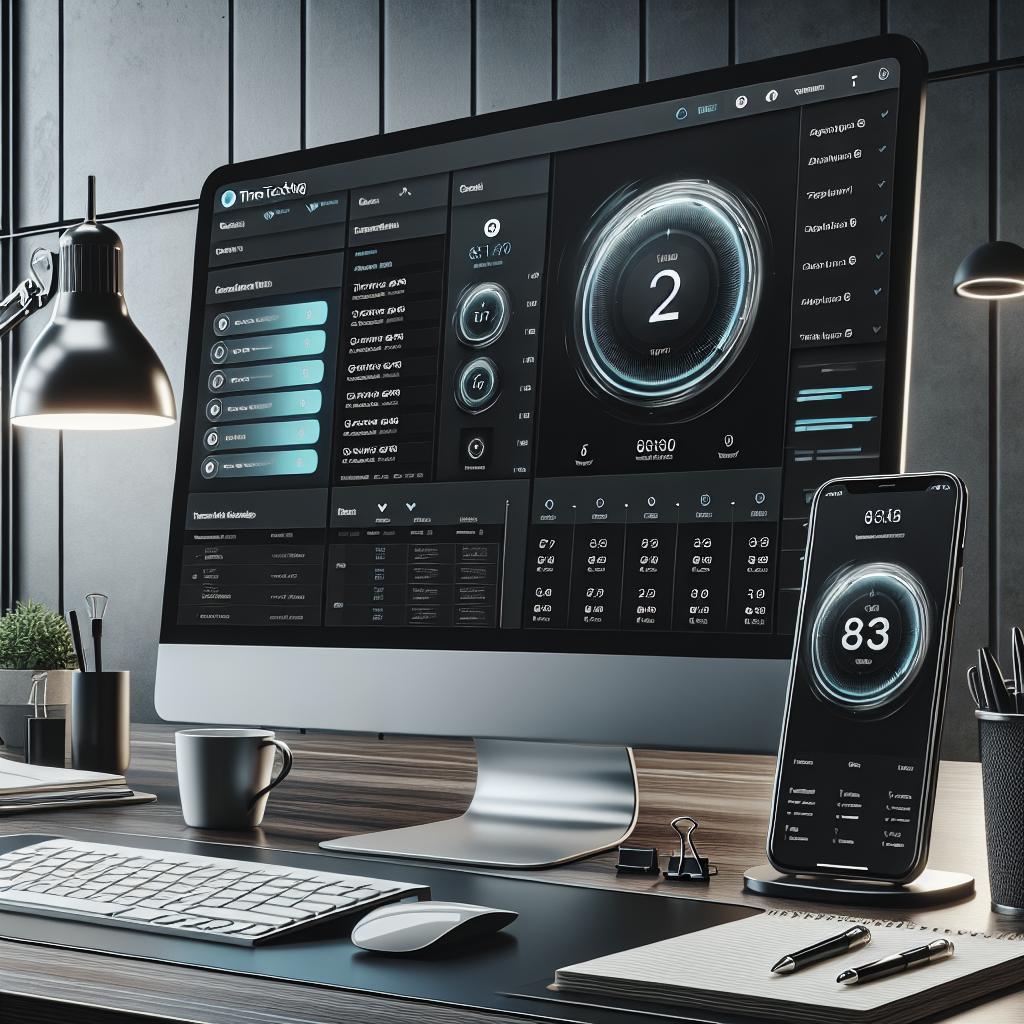In today’s fast-paced business world, time is a crucial asset. Effective time management can lead to increased productivity and streamlined operations, especially for large-scale enterprises. This blog post explores the best time tracking apps available, highlighting their unique features, usability, and the additional benefits they provide. We delve into what makes great time-tracking software and offer snapshots of each app at a glance. From free offers and auto-tracking capabilities to apps that visualize time differently, we cover a range of options suitable for various business needs. Get insights into top contenders like Toggl Track, Memtime, TrackingTime, Timeular, and Harvest, and discover the functionalities that can transform your enterprise time management practices.
The best time tracking apps
Selecting the right time tracking app can be pivotal in optimizing operations and enhancing employee productivity. With a multitude of options available, choosing the right app involves understanding each offering’s distinct capabilities.
Time tracking apps can vary widely in features, from simple manual time logs to sophisticated automated tracking and detailed reporting features. The best apps cater to both individual users and entire enterprises, ensuring that every second spent is accounted for with ease and precision.
What makes the best time tracking software?
Efficient time tracking software should go beyond basic timekeeping; it should act as a comprehensive tool that improves workflow management and delivers actionable insights. The best software will offer flexibility, compatibility with multiple platforms, and integration with other tools your team already uses.
Customization and automation are critical features that elevate a time tracking app from good to great. The ability to adapt to the specific needs of an enterprise while automatically logging activities reduces the likelihood of human error and enhances productivity.
The best time tracking apps at a glance
Here’s a quick overview of some of the leading time tracking apps that enterprises can leverage for improved productivity:
Toggl Track
: Ideal for those seeking a high degree of customization across multiple platforms.
Memtime
: Perfect for simplified auto-tracking of work activities.
TrackingTime
: Offers unique visualizations of time management data.
Timeular
: Known for its powerful automated time tracking features.
Harvest
: A simple yet feature-rich tool catering to a diverse range of user needs.
Best free time tracking app
Toggl Track (Android, iOS, Windows, macOS, Linux, Web, and browser extensions)
Toggl Track is a popular choice for those looking for a free time tracking solution that’s versatile and compatible with a wide range of devices and operating systems. Known for its clean interface and strong emphasis on project management, Toggl Track enables users to track time with precision across tasks and projects.
The app allows businesses to effortlessly keep track of how time is being allocated across multiple projects, providing insights into areas of strength and improvement. With integrations with several other productivity tools, Toggl Track helps maintain seamless operations.
Create detailed Google Calendar events for new Toggl Track time entries
One of Toggl Track’s standout features is its ability to integrate with Google Calendar, creating detailed events directly from time entries. This integration ensures all logged time is visually represented on your calendar, making it easier to manage and plan for upcoming tasks.
Create Google Sheets rows for every new time entry in Toggl Track
With the ability to automatically generate new rows in Google Sheets, Toggl Track provides users with an efficient way to manage data. This feature is especially beneficial for teams that rely on spreadsheets for data consolidation and analysis.
Create new Toggl Track entries for every new Google Calendar event start
By creating Toggl Track entries for each Google Calendar event start, this feature ensures that all meeting and event times are accounted for without the need for manual input. It bridges planning with time tracking seamlessly, reducing administrative burdens.
Best time tracking app for simplified auto-tracking
Memtime (macOS, Windows, Linux)
Memtime is an intuitive platform designed for users who prefer automated time tracking. With its capacity to track computer activity automatically, Memtime eliminates the need for manual input, thereby streamlining the time management process.
This app provides a seamless experience with its user-friendly interface and effortless integration across different operating systems. By focusing on uncomplicated auto-tracking, it helps businesses capture all productive and unproductive time spent on devices.
Best time tracking app for visualizing time differently
TrackingTime (Android, iOS, Windows, Mac, Web, Chrome, Firefox)
TrackingTime stands out for its innovative approach to visualizing time data. The platform’s graphical data representation capabilities make it easier for teams to analyze how time is being spent across various tasks and projects.
Another advantage of TrackingTime is its ability to deliver critical insights, allowing enterprises to see time allocation trends and make informed decisions. It’s an effective tool for those who prioritize visual data analysis as part of their time management strategy.
Create time activities in QuickBooks Online for new or updated time entries in TrackingTime
This app’s integration with QuickBooks Online is invaluable for businesses that track financial metrics alongside time. With automatic updates to time activities in QuickBooks, users ensure that billing and payroll are always accurate and up-to-date.
Add new TrackingTime time entries to Google Sheets rows
TrackingTime boosts convenience by enabling users to add new time entries directly into Google Sheets. This feature is ideal for those who prefer monitoring and analyzing data in spreadsheets.
Add rows to Microsoft Excel for new or updated time entries in TrackingTime
In leveraging Excel’s robust data processing capabilities, TrackingTime enhances user control over time data. This feature allows users to directly update their Excel spreadsheets with new or modified time entries, supporting comprehensive data handling and reporting.
Best time tracking app for automated time tracking
Timeular (Android, iOS, Windows, Mac, Web, Linux)
Timeular merges ease of use with powerful automated features to deliver superior time tracking capabilities. With its unique physical device for time logging, Timeular transforms the way enterprises record, manage, and analyze work time.
The app’s strengths lie in its automation abilities, which eliminate the need for manual entries, thereby increasing efficiency and accuracy in time tracking. Timeular is perfect for teams wanting to minimize overhead while maximizing productivity.
Log stopped Timeular trackings by creating new rows in Google Sheets
With the ability to log stopped trackings directly into Google Sheets, Timeular offers seamless oversight of all time usage metrics. It’s ideal for businesses focused on detailed and precise data records.
Create Timeular activities for new monday.com boards
This feature allows automatic creation of activities corresponding to new boards in monday.com. It streamlines workflows, ensuring all project-related time is consistently tracked within Timeular.
Create new Notion database items for Timeular time entries
This integration helps create new Notion database entries for every logged time entry in Timeular. It’s an excellent tool for teams that use Notion for project management and want seamless alignment between project and time data.
Best simple time tracking app with lots of extras
Harvest (Android, iOS, Windows, Mac, Web, and browser extensions)
Harvest is well-regarded for its simplicity, feature richness, and capacity to integrate with diverse tools. It is a powerful time tracking solution that also incorporates expense tracking, invoicing, and team management functionalities.
With a focus on ease of use, Harvest appeals to a broad array of users, from freelancers to large enterprises, ensuring that all aspects of time management are accessible and straightforward.
Create timesheet entries in Harvest when Google Calendar events start
Harvest’s ability to sync directly with Google Calendar to create timesheet entries as events begin helps ensure that all appointments are systematically captured, thereby simplifying time management and reporting.
Create Harvest projects from new Asana projects
For teams who heavily use Asana for project management, Harvest offers the ability to create new projects seamlessly, ensuring no time is lost and that all project times are recorded throughout their lifecycle.
Create new Harvest projects from updated deal stages in HubSpot
By allowing Harvest projects to be auto-created when HubSpot deal stages are updated, businesses can more effectively correlate sales and project management data, promoting more strategic oversight and allocation of resources.
What makes the best time tracker?
The best time trackers are those that effectively blend simplicity with powerful features to enhance productivity and operational efficiency. They should provide accurate data, robust analytics, and seamless integrations with other enterprise tools.
Additionally, customization options are key, enabling companies to tailor reports and dashboards to their specific needs. Automation further appeals to streamline processes and reduce time spent on management tasks, all contributing to a more productive work environment.
What’s not included in this roundup
While this guide highlights some of the top time tracking tools available today, it is by no means exhaustive. There are many other solutions available, though they may not offer the comprehensive features or enterprise-focused integrations that render them prime candidates for our list.
Furthermore, some industry-specific tools or proprietary systems offered by consulting firms or larger enterprises may also meet unique business needs not covered here. As business requirements continue to evolve, exploring new releases and updates is essential for staying ahead.
Final thoughts
| Category | Time Tracking App | Key Features |
|---|---|---|
| Best Free App | Toggl Track | Multi-platform compatibility, Google Calendar and Google Sheets integration |
| Simplified Auto-Tracking | Memtime | Automatic computer activity tracking |
| Visualizing Time | TrackingTime | Graphical time data, QuickBooks, and Excel integration |
| Automated Tracking | Timeular | Physical device logging, Google Sheets and Notion integration |
| Simple App with Extras | Harvest | Invoicing, expense tracking, Asana, and HubSpot integration |


